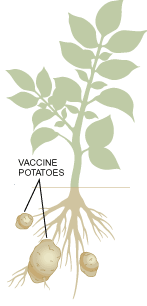There’s been a noticeable shift towards consumer-driven changes in food production over the past year. Movements advocating for non-GMO or organic foods influence market trends, pushing companies towards transparency or avoiding GM ingredients altogether, which indirectly addresses our “Frankenstein food” concern by promoting natural or traditionally bred alternatives.
There’s just one problem – the government and Big Pharma and Food
Frankenstein food includes crops where edible vaccines are genetically modified crops to contain antigens for specific diseases. They are created by introducing the desired gene into the edible part of the plant to manufacture the encoded protein. This reduces the cost of production of the vaccine because of ease of culturing. Eating a vaccine is also a simpler means of administration compared to injection, making them extremely economical. They are easy to grow, are low cost, and easy to transport and preserve.
They have not been researched enough to know what the longterm effects might be. We have no idea how this will work. And yet our Big Pharma funded government is all ready to embrace them.
Scientists, funded with your tax dollars, are trying to turn edible plants like lettuce and spinach into mRNA vaccine factories. It's dangerous to play God with our food. The House just passed my amendment to prohibit USDA funding of this research. pic.twitter.com/XEyWGGZm5q
— Thomas Massie (@RepThomasMassie) September 27, 2023
There’s been a push towards refining how GMOs are regulated, especially with the advent of new breeding techniques (NBTs) like CRISPR. Countries are debating whether to classify these new gene-editing technologies under the same strict regulations as traditional GMOs or to create new, potentially more lenient, frameworks that focus on the end product rather than the process used to create it. This shift could influence how GMOs are developed, ensuring they meet safety standards without unnecessary restrictions that might hinder beneficial innovations.
CRISPR, which stands for Clustered Regularly Interspaced Short Palindromic Repeats, might sound complex, but think of it like a very precise pair of molecular scissors that can cut and edit DNA.
Here’s how it relates to genetically modified organisms (GMOs) and food in a way that’s easier to grasp:
What is CRISPR? Imagine your DNA as a long instruction manual for your body. Now, CRISPR is like a tool that can find a specific page in that manual, cut out a sentence, and either remove it or replace it with a new one. This technology allows scientists to make very precise changes to the DNA of living organisms, which could mean fixing genetic defects, making plants resistant to diseases, or enhancing certain traits like nutritional content.
CRISPR and GMOs:
- Traditional GMOs: Before CRISPR, if you wanted to modify an organism’s DNA, you might use methods like inserting genes from another organism, which could be seen as adding whole paragraphs from another book into your DNA manual. This often led to the organism being labeled as a GMO, which in many places requires strict regulations and labeling.
- CRISPR’s Role: CRISPR can make changes so precise that it’s like editing just one word in your DNA manual. This has led to debates about whether these edited organisms should be considered GMOs. Some argue that if you could theoretically achieve the same change through traditional breeding (which just takes much longer), then maybe these shouldn’t be regulated as heavily. Who are these people? Lobbyists?
Efforts to Address Concerns Over GMOs always favor the producer:
- Regulation Changes: There’s a push towards looking at the end product rather than the process. If a plant looks and behaves like it could have occurred naturally or through traditional breeding, should it be regulated the same way as a plant with foreign genes inserted? This debate is ongoing, with some regions moving towards a product-based approach rather than a process-based one.
- Transparency and Labeling: Public demand for knowing what’s in their food has led to discussions about labeling. If a food has been gene-edited, should it be labeled? There’s a divide here. Some believe in full transparency, (us) while others argue that if the end product is safe and indistinguishable from a non-GMO counterpart, labeling might not be necessary or could confuse consumers. Because they think we’re dumb.
- Public Perception and Education: There’s an effort to educate the public about what gene editing means. Not all genetic modifications are the same. CRISPR could be used to make crops more nutritious or resistant to climate changes, potentially benefiting food security. However, there’s also concern about unintended consequences, like off-target edits, which could affect health or the environment.
In essence, CRISPR represents a leap in how we modify organisms, potentially making GMOs more acceptable or less controversial if they’re seen as just an extension of traditional breeding.
However, the debate over how to regulate, label, and perceive these new organisms continues, reflecting broader societal values about food, nature, and technology.
Depopulation is real
Did you know a company called Epicyte made an anti-fertility corn that creates anti-sperm antibodies back in 2001 with the expressed intent of one day "saving the world from overpopulation"?
— Inversionism (@Inversionism) November 18, 2023
The initial idea and foundational research came from work done by the WHO on… pic.twitter.com/BFlLjgR0mF
